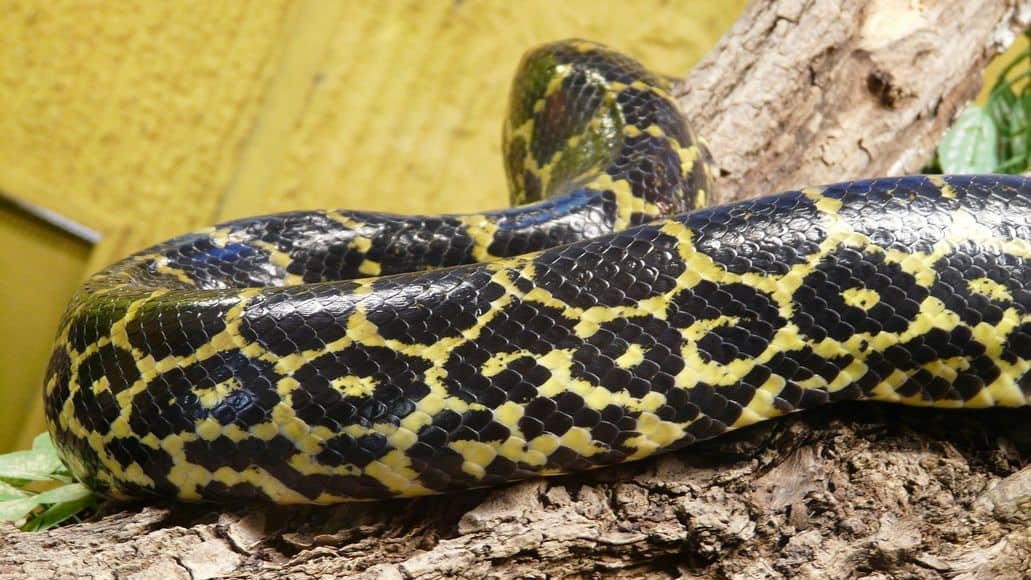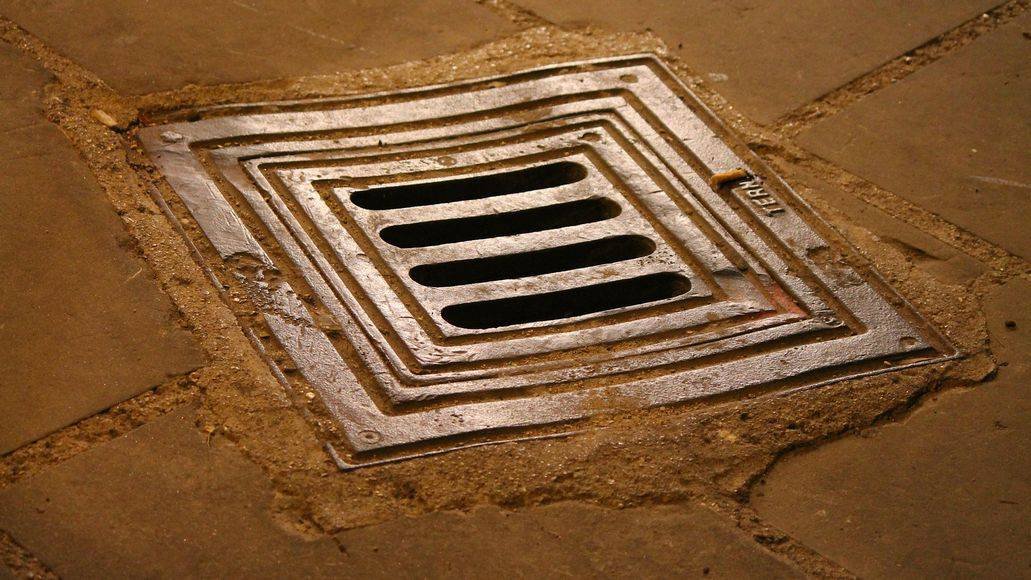
Have you seen the movie Anaconda?
It’s not great, but a fun watch. In fact, it’s one of the best snake movies out there. But it’s fiction.
Here’s your first anaconda fact: while they are giants, these snakes are not the man-eating monsters Hollywood would have you believe.
In the movie, a documentary film crew journeys deep into the Amazon rainforest in search of Shirishama Indians, when they encounter a giant snake that wants nothing more than to squeeze the life out each and every one of them.
In real life, the snake would do it’s best to remain undetected and the film crew would likely never even know it was there. It would also be far smaller.
Let’s take a look at 10 fascinating facts about anacondas, to give you a more realistic view of these amazing serpents.
Table of Contents
- 1 Facts About Anaconda Snakes
- 1.1 Fact 1: There Are Four Recognized Species Of Anaconda
- 1.2 Fact 2: Anacondas Can Live Over 30 Years
- 1.3 Fact 3: Anacondas Never Stop Growing
- 1.4 Fact 4: People Keep Anacondas As Pets
- 1.5 Fact 5: Anaconda Enclosures Require A Floor Drain
- 1.6 Fact 6: Anacondas Require A Pool In Their Enclosure
- 1.7 Fact 7: Anacondas Are Calm Pets But They Can Turn Aggressive
- 1.8 Fact 8: Anacondas Swallow Their Prey Whole
- 1.9 Fact 9: Anacondas Reach Sexual Maturity At 3 To 4 Years
- 1.10 Fact 10: Females May Eat Males After Mating
- 2 Facts About Anacondas: Final Thoughts
Facts About Anaconda Snakes
Known as the water boa, the anaconda is an apex predator. It sits at the top of the food chain. These snakes are found in tropical South America and are one of the largest snakes in the world.
They are large and cumbersome on land, but are known for their excellent swimming abilities. The Greek name for this snake is Eunectes Murinus, which means ‘good swimmer.’ Their movement in the water sounds impressive to us at home, but is incredibly frightening if you’re prey, and trying to get away.

Let’s dive right in and look at 10 more fascinating facts about anaconda snakes.
Fact 1: There Are Four Recognized Species Of Anaconda
Anacondas belong to the genus Eunectes. They are classified into four species:
- Beni anaconda (also known as Bolivian anaconda)
- Dark-spotted anaconda
- Green anaconda
- Yellow anaconda (also known as Paraguayan anaconda)
The Green Anaconda is the most interesting to most people, because it is the heaviest, and one of the longest, snakes in the world. It is usually dark green in color, with green, brown and yellowish spots, although coloring and size depends on the species.
Fact 2: Anacondas Can Live Over 30 Years
Anacondas generally live 10 to 12 years in the wild, but they can live more than 30 years when kept in captivity. The Green Anaconda called Annie, who makes her home at the Montecasino Birds Garden in Johannesburg, is the world’s oldest anaconda. At last report, she celebrated her 36th birthday in 2019.
Fact 3: Anacondas Never Stop Growing

These snakes never stop growing throughout their lifetime, which is one of the reasons they become so massive. National Geographic and other publications list the anaconda’s maximum verified length as 29 or 30 feet.
However, snake experts who have actually caught and measured many anacondas say they don’t grow much longer than 20 feet and the Guinness Book of World Records lists the longest ever recorded snake as a 25-foot reticulated python.
The same snake experts say that the average size of female anacondas is roughly 20 feet, with males being smaller and only measuring in at about 9 feet.
The reported weight of these snakes also varies greatly. National Geographic says they can weigh 550 lbs, but the average weight is likely to not be much more than 150 lbs.
Fact 4: People Keep Anacondas As Pets

When anacondas first appeared in the snake trade, they were imported and did not arrive in good shape. They were generally bad-tempered and usually ridden with parasites. They were stressed, sick, and disinterested in eating.
The bad condition they arrived in, combine with a lack of knowledge about the habitats and habits of these snakes, resulted in high mortality rates.
Fortunately, things have improved. Proper veterinary care, and more knowledge about these huge creatures, has led to some imported animals thriving and now becoming established domestically.
They are also able to reproduce in captivity with greater success, meaning that they are now more easily available. However, only green and yellow anacondas are available in the pet trade.
People who have experience keeping anacondas as pets recommend the yellow over the green, mainly because it’s a smaller snake and thus easier to care for.
Fact 5: Anaconda Enclosures Require A Floor Drain
Whether you keep the green or yellow anaconda, both are incredibly strong. Considering their strength and the potential dangers it can present, the cage will need to be a veritable fortress.
It also needs to be easy to keep clean. These huge snakes produce a lot of waste and the cage will need a floor drain.

You will need to be well set-up to house such a huge snake. Captive-bred anacondas can make calm pets, but they get large. It isn’t a particularly good choice of a snake for anyone who doesn’t have sufficient experience working with- and keeping such large constrictors.
For yellow anacondas and male green anacondas, you can get by with about 25 square feet of space, while a female green anaconda will need a larger enclosure of at least 50 to 100 square feet.
You need to maintain a temperature of about 84° to 88° Fahrenheit during the day, and about 77° to 82° Fahrenheit at night.
Fact 6: Anacondas Require A Pool In Their Enclosure
Not only do anacondas need large enclosures, they also need a swimming pool to swim in. These snakes can hold their breath for up to 10 minutes and water plays a big part in their lives.
Fact 7: Anacondas Are Calm Pets But They Can Turn Aggressive

When anacondas are well-socialized, they are docile pets. But even then, you have to be very careful with children and other pets in the home.
No matter how calm they may generally be, these snakes can be dangerous simply because of their size. It is this that makes them unsuited for inexperienced snake owners.
It also makes them illegal in many areas. You need to check that keeping an anaconda is legal in your area, before looking to keep one as a pet.
This is particularly so when these snakes haven’t been well treated, they’re hungry, aggressive and dangerous. If these snakes aren’t fed properly or they feel threatened, they can attack and try to constrict the person they are attacking.
Fact 8: Anacondas Swallow Their Prey Whole

Anacondas are nocturnal, nonvenomous constrictors, that hunt for a variety of prey.
They love capybara, but enjoy other rodents too. Fish, pigs, deer, and jaguar can also be on the menu. They lurk in rivers, and their coloring blends in with the murky waters, fooling their prey.
They’ve got nostrils and eyes on the tops of their heads, so they can see above the water while keeping their body submerged.
Anacondas can stay under water for 10 minutes before resurfacing for air. They wait by the shore for animals to approach the water to quench their thirst and then they attack. The snake uses its sharp teeth to restrain its prey.
There are different theories as to how the snake actually applies its constricting methods.
They can crush the bones of their prey or suffocate the very life out the animal. Because this constriction happens in water, it is thought that the animal the snake has caught may also drown. Either way, the green anaconda is the most powerful constrictor snake there is, so the prey does not have much of a chance.
Once the prey is dead, the anaconda swallows it whole. A large animal can be a massive undertaking even for a large snake.
The anaconda has a special mouth designed to tackle these large animals. It has an unfused ligament on each side of its mandibles and mobile joints in its jaws. This combination allows the snake to open its jaws wide enough do fit over large prey.
But how do snakes digest bones? They produce a lot of stomach acid and they take many days, and even weeks, to digest. This gives the strong acid plenty of time to break down any bones in the prey.
Fact 9: Anacondas Reach Sexual Maturity At 3 To 4 Years
Green anacondas reach sexual maturity at about 3 to 4 years of age. Yellow anacondas breed annually, but female green anacondas only breed every other year. This is because they have quite a taxing reproduction process and they need to regain their strength and energy for the next reproduction orgy.

From March to May, these giant constrictors abandon their solitary lifestyles and spend a long time mating. For many male green anacondas, these lusty pairings end in death. The female often consumes them to help nourish her through the gestation period.
The females start the mating process by leaving a trail of pheromones. The males then search for the females. The male’s forked tongue flicks as he gathers different scents from the ground and air. The Jacobson’s organ in the roof of the snake’s mouth enables the reptile to smell, taste and locate prey.
Or, in this case, a female in heat. The green anaconda is polyandrous – this means she practices polygamy – taking a number of mates from the many that respond to her pheromones.
The snakes form a mass of writhing bodies. This is known as a breeding ball. The female anaconda snake is stimulated by the males’ spurs, and mating takes place with the male’s tail coiled around her.
These breeding balls last for a number of weeks with the female mating with many males. Female anacondas, both the green and the yellow, are bigger and stronger than the males and they have the final say over which males they mate with.
Fact 10: Females May Eat Males After Mating
As mentioned, the female anaconda may well ingest a couple of males to tide her over the long gestation period that awaits her. She relies on this food when it becomes difficult for her to forage around.
Gestation lasts 6 to 7 months. The impregnated female is ovoviviparous and incubates her eggs.
The young snakes are in clear membranes. When it is birthing time, the snake moves to shallow water and can give birth to as many as 80 or 90 live young, though 20 to 40 is more usual. They are born through the cloaca and not the mouth, as some believe.
Babies are about 2 feet long. The young are independent right at birth and the mother anaconda doesn’t stay around to offer any parental supervision and care.
Facts About Anacondas: Final Thoughts
Anacondas aren’t endangered, but with the persecution they face from human beings, their numbers could be under threat soon.
They are falsely known as ‘man-eaters’, and while there are always stories coming up of humans being eaten by anacondas, none of the stories have been verified.
That said, an anaconda is certainly capable of eating a human, even though humans are not their first choice of food. And only children would realistically be on their menu. Most fully grown adults would likely be too much for them to stomach.
Despite that, we do not recommend testing this theory. Even though there are no official reports of an anaconda eating a human, why risk becoming the first?
Leave a Reply